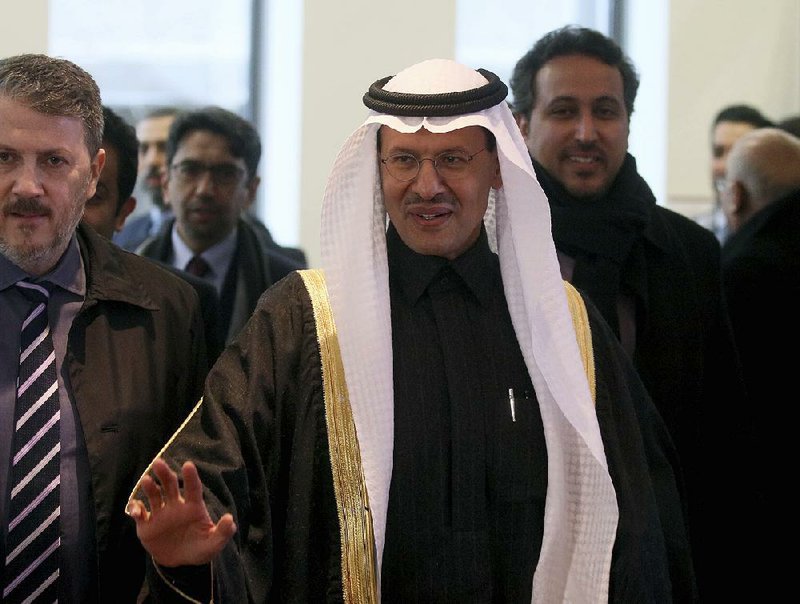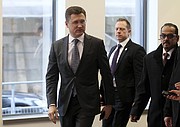OPEC and Russia agreed Thursday to make further small cuts in oil production to firm up crude prices and compensate for higher output from the United States and other producers outside the cartel.
Meeting in Vienna, OPEC and Russia decided to deepen recurring cuts over the past three years by an additional 500,000 barrels a day, the equivalent of 0.5% of global output, through the end of March.
An official announcement is expected today, but the main points of an agreement were told to analysts attending the conference.
Oil prices barely moved on the news, largely because it will take time to see whether producers abide by the agreement.
A leading proponent for cuts at the meetings has been Iraq, which, along with Nigeria, has regularly cheated on past agreements. Meanwhile, Russia has neglected to abide by its commitments this fall.
The cuts in production from Venezuela and Iran have been involuntary, largely because of U.S. oil sanctions and political crises. Other nations including Angola, Azerbaijan and Mexico have been unable to sustain their production because of natural declines.
"A lot of key details are still missing which will help the market determine whether this is a substantial or symbolic cut," said Helima Croft, head of global commodity strategy at RBC Capital Markets.
Analysts note that if countries are already not complying with the current agreement, voting for more cuts could be pointless.
"I think the Saudi position is they're willing to cut more if needed, but they want better compliance," said Bhushan Bahree, executive director of global oil at research group IHS Markit.
Crucially, the new quota that applies in the first quarter of 2020 would come only into force if all members of OPEC and its allies implement 100% of their pledged curbs, Russian Energy Minister Alexander Novak said in a Bloomberg TV interview. That's something the OPEC Plus alliance has struggled to achieve throughout the three years of its existence.
Once the powerhouse of the global oil market, OPEC now largely reacts to trends outside its control, particularly U.S. oil production, which has doubled to 12 million barrels a day since 2012.
OPEC production cuts have done little to raise crude prices in recent years, largely because of the steady increase in U.S. shale oil production, mainly in west Texas. U.S. output is expected to increase more slowly next year, but nearly 1 million new barrels a day are expected to reach global markets from Norway, Brazil, Mexico and Guyana.
This month's OPEC meeting has drawn attention because it is the first in which the newly appointed oil minister, Saudi Prince Abdulaziz bin Salman, the half brother of Crown Prince Mohammed bin Salman, was in charge of Saudi energy policy. His chief objective was to firm up oil prices to make the initial public offering of Saudi Aramco as attractive as possible.
On Thursday, Aramco set a price for its shares at a level that will raise $25.6 billion, which is expected to make it the world's biggest initial public offering.
Saudi Arabia is always the key mover at OPEC meetings. The kingdom, which produces 10.3 million barrels of oil a day, more than one-third of the OPEC members' total, has made the lion's share of cuts in recent years and is expected to continue doing so.
Saudi Arabia has been pressuring Iraq to make cuts and has offered Baghdad economic aid, but the recent collapse of the Iraqi government of Prime Minister Adel Abdul Mahdi and the expected long process to select a successor puts any Iraqi agreement in doubt.
Saudi Arabia and Russia have been at the heart of a 3-year alliance of oil producers known as OPEC Plus -- which now includes 11 OPEC members and 10 non-OPEC nations -- that aims to shore up oil prices with production cuts.
Russian delegates at the OPEC meeting pressed for an exclusion of natural gas liquids from their cuts, potentially carving out a loophole that will allow them to pump more even while technically keeping their commitments.
OPEC currently produces 29.7 million barrels a day -- about 30% of global output -- which is 2.6 million barrels a day fewer than a year ago. A little less than half of that reduction comes from OPEC agreements, with the rest of the shortfall coming from Venezuela and Iran.
Rystad Energy, a Norwegian consultancy, has estimated that the global oil market will be oversupplied by 800,000 barrels a day because of the new production and slowing economic growth. Bjornar Tonhaugen, Rystad's head of oil market research, has warned that the global Brent oil benchmark, just above $60 a barrel Thursday, could dip into the $40 to $50 range "if OPEC and Russia don't extend and deepen their cuts."
The deal's expiration at the end of March comes right in the middle of what looks to be a tricky patch for the oil market. Demand growth is slowing, and another big expansion in rival production is coming down the pipeline.
Those factors could create another oversupply that drives international prices back down toward $50 a barrel. That's too low for most OPEC members to balance their budgets and would make an unfortunate epilogue for the record-breaking initial public offering of Aramco.
The state-owned oil giant set the final price of its shares at $8.53, valuing the world's most profitable company at $1.7 trillion. It received total bids of $119 billion.
For the crown prince, the sale could help restore credibility undermined by setbacks to his blueprint to overhaul the economy and a global reputation tarnished by the murder of Washington Post columnist Jamal Khashoggi and the war in Yemen.
But the deal ended up being very different from what the prince had envisaged when he first floated the idea in 2016 with an ambition to raise as much as $100 billion. Aramco offered just 1.5% of its shares and opted for a local listing after global investors balked at its hopes of valuing the company at $2 trillion.
Instead, Aramco relied heavily on local investors and funds from neighboring Gulf Arab monarchies. In the offering for individuals, almost 5 million people applied for shares.
The kingdom's richest families, some of whom had members detained in Riyadh's Ritz-Carlton hotel during a so-called corruption crackdown in 2017, are expected to have made significant contributions. Global banks working on the deal were sidelined after Saudi Arabia decided to focus on selling the shares to local and regional investors.
Still, Aramco will become the world's most valuable publicly traded company once it starts trading next week, overtaking Microsoft and Apple.
Information for this article was contributed by Clifford Krauss of The New York Times; by Kiyoko Metzler, David McHugh and Cathy Bussewitz of The Associated Press; and by Salma El Wardany, Grant Smith, Golnar Motevalli, Nayla Razzouk and Matthew Martin of Bloomberg News.
A Section on 12/06/2019

